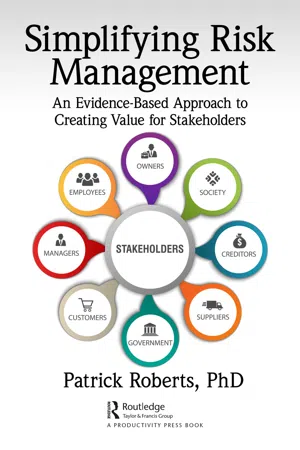Business
Risks and Rewards of Running a Business
Running a business involves both risks and rewards. Risks can include financial losses, market competition, and operational challenges. On the other hand, the rewards can encompass financial success, personal fulfillment, and the opportunity to make a positive impact. Balancing these risks and rewards is essential for the long-term success of a business.
Written by Perlego with AI-assistance
Related key terms
1 of 5
3 Key excerpts on "Risks and Rewards of Running a Business"
- No longer available |Learn more
Entrepreneurial Leadership
Finding Your Calling, Making a Difference
- Richard J. Goossen, R. Paul Stevens(Authors)
- 2013(Publication Date)
- IVP(Publisher)
Risk and Reward The capacity to manage risk, and with it the appetite to take risk and make forward-looking choices, are key elements of the energy that drives the economic system forward.Peter L. Bernstein, Against the GodsOne significant element of business in general and entrepreneurship in particular is the balance between risk and reward. Risk is undertaken for a reason—for gain that is determined to be reasonable in light of the possible reward. The word risk derives from the early Italian riscare , which means “to dare.”[1] Entrepreneurs constantly balance and assess daring to innovate with the likelihood of rewards in the event of success. We will first examine risk and then later turn to reward.Entrepreneurs are at the cutting edge of business or not-for-profits with their pursuit of innovation, typically doing what has not been tried previously and anticipating that they can master the forces of risk. The reality is that many entrepreneurs miscalculate risk and their businesses fail. On the other hand, entrepreneurs that successfully manage risk by judging and anticipating market trends reap commensurate rewards. Money is lost and gained in various sectors, from mineral exploration to high tech and social media. Between the headlines recounting the tales of the winners and losers is the ongoing tale of managing risk. While we admittedly approach these questions from the perspective of the Christian faith, we believe that people of all faith traditions can profit from the following analysis of risk and reward.The Risk-Taking Entrepreneur
Without some risk there will be no innovation. But successful entrepreneurs are neither risk averse nor risk addicted. Peter Drucker believes entrepreneurs are not risk-focused but opportunity-focused.[2] They minimize risk rather than maximize it. Drucker argues that innovation is considerably less risky than optimization. “Entrepreneurs, by definition, shift resources from areas of low productivity and yield to areas of higher productivity and yield. Of course, there is risk they may not succeed. But if they are even moderately successful, the returns would be more than adequate to offset whatever risk there might be.”[3] Thus, he concludes, “Theoretically, entrepreneurship should be the least risky rather than the most risky course.”[4] - eBook - PDF
Managing Risk in Organizations
A Guide for Managers
- J. Davidson Frame(Author)
- 2003(Publication Date)
- Jossey-Bass(Publisher)
People launch and 177 Q run businesses to make money. In general, if they enter into a safe business—for example, running an established convenience store— they are not likely to make great incomes, but neither are they likely to lose much. If they develop a technology breakthrough, they have a chance to make a fortune, as well as an opportunity to lose their life savings. All decisions that businesspeople make are risky to some extent. For example, each time you hire new employees, you are taking a risk. There are no guarantees that you have made a good choice. What if the employee does not work out? What if he can’t follow instructions and continually makes errors in doing his job? Hiring employees can be expensive. If ultimately they are fired after several unsatisfactory months, crucial work has not been done and you find yourself back at square one. As another example, advertising a new product in the newspaper can be expensive, and there are no guarantees that it will generate revenue. Will your $10,000 advertisement reach the cus- tomers you are targeting? What if the ad is buried in the back pages of the newspaper? What if it does not generate even one customer inquiry? Business risk can be visualized in different ways. The approach taken here is captured in Figure 10.1, which shows business risk as 178 MANAGING RISK IN ORGANIZATIONS Operational risk Market risk Financial risk Regulatory risk Project risk Business risk Figure 10.1. Principal Components of Business Risk. comprising five components: market risk, financial risk, operational risk, project risk and regulatory risk. Market Risk All businesses that sell goods and services are concerned with market risk. Market risk is captured in the following basic question: When we put a product into the marketplace, will it sell? Clearly, this issue is of utmost concern to companies that introduce new products. The prob- lem with new products is that they have no track record. - eBook - PDF
Simplifying Risk Management
An Evidence-Based Approach to Creating Value for Stakeholders
- Patrick Roberts(Author)
- 2022(Publication Date)
- Productivity Press(Publisher)
1 Chapter 1 What Do We Mean by Risk? This is categorically not an academic text, and this chapter is not a discussion of semantics. But, in order to have a produc-tive discussion of why and how we try to manage risk within organisations (and indeed how we measure the effectiveness of our attempts to do so) in subsequent chapters, some clarity is needed on what is meant by the word. This chapter begins by looking at some fundamental issues around how risk may be defined. This leads naturally into a discussion of the risk perspectives of different stakeholder groups, focusing particularly on owners, senior managers and lenders. This is followed by a brief discussion of how the ten-sions that inevitably arise between these different stakeholder groups may be managed. The chapter concludes by briefly reviewing some common risk measures and categorisations of risk that will be of utility in later chapters. DOI: 10.4324/9781003225157-1 2 ◾ Simplifying Risk Management Upside and Downside Risk In everyday usage, the term “risk” generally has negative connotations - few people talk about the risk of a pay rise or promotion at work, or the risk of their team winning the FA Cup – and many academics and practitioners follow this con-vention. However, others argue that risk concerns both posi-tive and negative outcomes, e.g. “Risk is defined as uncertainty of outcome, whether positive opportunity or negative threat” (Chittenden (2006, p.9)). In particular, within the finance lit-erature, there is a long history of equating risk with variance in returns, an entirely symmetrical measure of variability in outcomes. As will be discussed in more detail below, in any given situation, different stakeholders may quite legitimately take different views on whether positive outcomes are relevant to their risk perspective.
Index pages curate the most relevant extracts from our library of academic textbooks. They’ve been created using an in-house natural language model (NLM), each adding context and meaning to key research topics.


